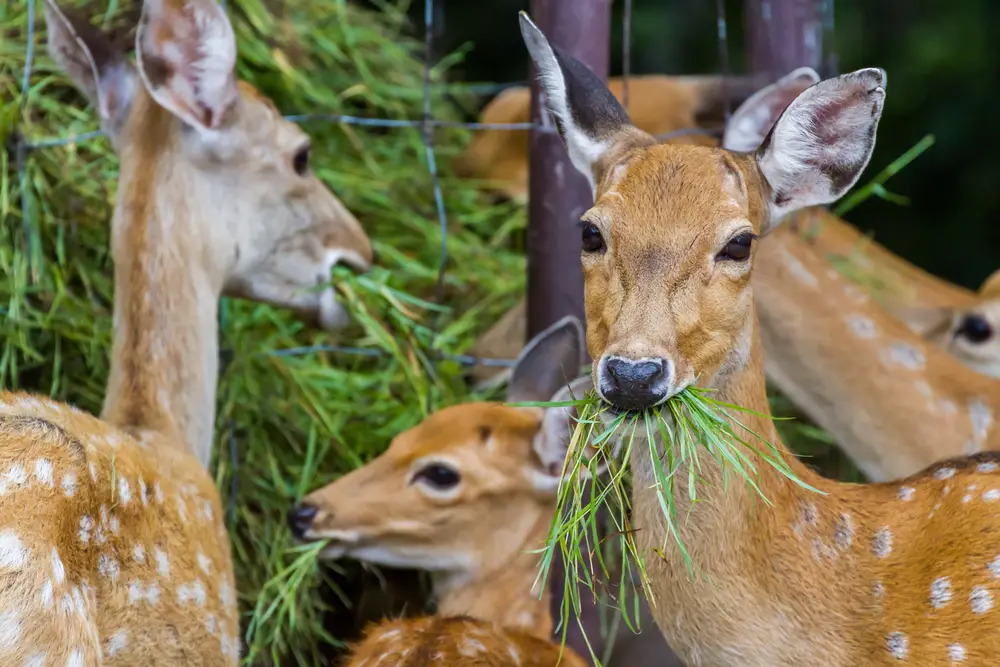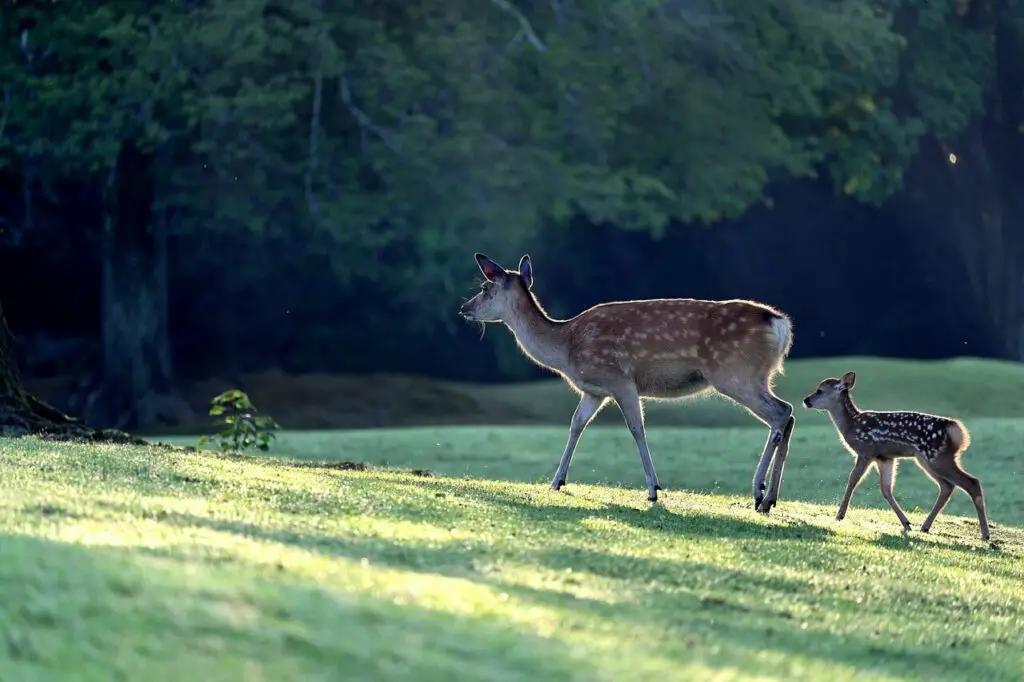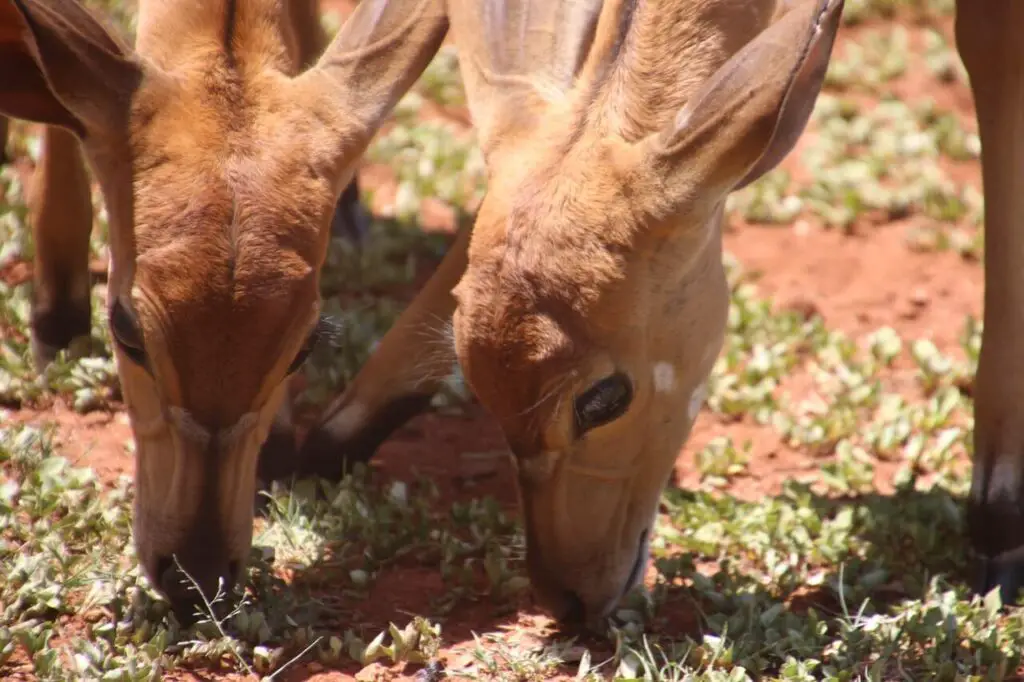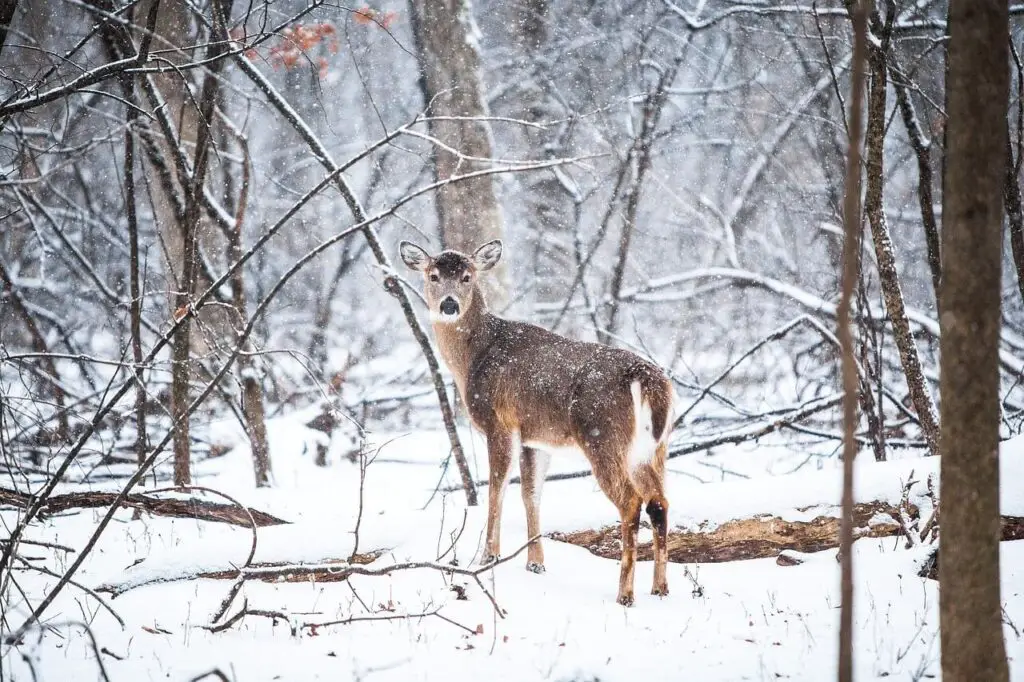If you’re wondering “what do deer eat?”, then this article is for you!

Today, we’re sharing a full guide to the deer diet and answering many common questions regarding diet selection, deer-favorite garden plants, deer-resistant vegetables and herbs, the hazards of inappropriate winter feeding of deer, and how to properly start and maintain a feeding process.
Sound interesting? Let’s jump right in!
Table of Contents
Do Deer Eat the Same Food as Cows?

We want to start this guide by clearing up a misconception that has been going around for a long time. When thinking about a deer’s diet, a lot of people have their minds immediately travel to the diet of cows.
Statements such as “there’s plenty of green stuff here, the deer can’t be starving” are commonly spoken about deer. They imply that deer would eat anything as long as it’s a green plant – as a cow would – which couldn’t be further from the truth.
In reality, the food habits of cows and deer are so different that they represent opposite ends of the ruminant diet spectrum. Ruminants are herbivorous mammals with a special digestion system that’s capable of extracting nutrients from plant-based food by fermenting in a four-chambered stomach.
Let’s discuss the difference between cows and deer when it comes to diet and eating.
If you observe a cow from above, you’ll see it has a wide nose and a broad tongue that the animal uses to consume a large variety of plant species, with a particular affinity to grasses.
In cows, the rumen (first stomach chamber) is large enough to accommodate at least 49 gallons of food material. It’s one of the densest microbial habitats in the world, home to a highly diverse population of bacteria, protozoa, yeasts, and other organisms that work together to break down ingested feed via a fermentation process (a specialty function for digesting specific groups of plants).
This is why cows have the ability to digest grasses although they’re the most fibrous and indigestible of plants. As such, cattle are classified into a group of ruminants known as “roughage eaters”.
On the other hand, whitetails – the most common large land mammal in North America – belong to a group called “concentrate selectors”. Looking at this deer species from above, it’s obvious that their snouts are narrow and sharply pointed to help them reach into plants and seek out specific parts to consume.
A whitetail deer’s tongue is long and slim, which allows for the extraction of fluids from succulent leaves and stems. Their rumen has a capacity of approximately 2 gallons — that’s about 4% of a cow’s rumen.
Not only do deer have much smaller rumens, but also the microbial habitat there isn’t nearly as diverse. As such, deer need to refill their rumen with food materials every few hours to maintain the more specialized flora and fauna.
How Do Deer Choose Food?
With a smaller rumen and much less diverse microbial presence, the question now is: how do deer choose what to eat? Well, to better explain how diet selection works in whitetail deer, we’ll first discuss what these animals are designed to consume.
The anatomy, physiology, and behavior of deer lead them towards the selection of certain types of forage that don’t bear competition from other forage eaters such as cattle, moose, and elk. As we mentioned above, deer have narrow snouts and long, slender tongues that allow them to reach specific plant parts.
Additionally, deer have highly active salivary glands that secrete enzymes to break down secondary plant compounds that often hinder digestion in other animals. For example, tannins.
Thanks to these enzymes, deer are able to consume acorns in amounts that’d otherwise kill a cow. Also, their comparatively smaller and less complex digestive tract requires that they eat a diet consisting of relatively higher quality forages that are more easily broken down than forages consumed by cattle, moose, and elk.
The reason for this diet difference lies in the speed of the digestive process in both animal groups. So even though cattle and elk receive adequate nutrition from lower quality forages like mature grasses, the quicker digestive process of whitetails demands food materials that are more readily digestible forages to swiftly deliver their energy and nutritive requirements.
Evidently, whitetail deer in severely overpopulated and depleted regions have starved to death and were found with stomachs full of low-quality forages.
Generally speaking, deer consume several food types including browse (leafy elements of woody plants), forbs (herbaceous wide-leaved plants or weeds, such as agricultural crops), hard and soft mast (seeds and fruits), grass, as well as mushrooms/lichens. Still, you should note that diet selection is affected by seasonal changes in forage abundance, quality, and the metabolic requirements of the animal at the time of feeding.
How Many Species of Plants do Deer Eat?
If we were to put together a list of all plant species that deer eat, we’d be here for a really long time. Whitetails, for example, have been documented to consume more than 400 species of plants in just the Southeast.
For deer, regular sampling from an extensive range of plant species is necessary as it allows them to keep finding new sources of nutrients. That being said, the majority of deer diets were found to include a relatively small number of forages.
In a recent study, it was shown that deer consumed over 140 plant species, but only about a third of those species made up 93% of their overall diet.
What Do Deer Prefer to Eat?

Now let’s talk in more detail about the types of food that are preferable to deer. As we mentioned earlier, deer like to consume browse, forbs, grasses, mast, and mushrooms.
The availability of each of these food categories in a certain region varies according to the time of year and climatic conditions.
- Browse: Leafy parts of plants such as shrubs or young trees within reach of deer are called browse, which also happens to be the most consumed food item by deer.
The reason is simple: browse plants are always readily available regardless of the time of year and the weather conditions. Deer can always find them in one form or another.
While it’s true that drought or cold weather can cause browse plants to lose their leaves, their stems and twigs continue to preserve adequate nutritional value, unlike forbs that just go away.
- Forbs: Even though studies show that forbs are the most preferred food type for whitetail deer, they don’t consume these plants nearly as much as browse. The reason behind this is undependability.
Forbs are indeed more digestible and nutrient-rich than browse, but they aren’t always around when deer need them. Unlike hardy browse, cold temperatures and prolonged droughts dry periods prevent the growth of forbs, so they aren’t a reliable food supply.
- Mast: Generally, mast includes acorns, nuts, seeds, and fruits. They’re an excellent source of energy during times of thermal stress or active growth of the body and antlers.
In the fruit department, grapes, plums, blackberries, and mulberry are among deer favorites. These are high-energy foods with high carbohydrate levels that are particularly useful during antler growth. Other soft fruits that deer like to consume in the fall are energy-loaded apples and pears.
Acorns and chestnuts are the two most important food items in a deer’s diet when it comes to nuts, where each one serves different nutritional needs.
Acorns contain high levels of fat and carbohydrates, but they’re low in protein. On the other hand, chestnuts are packed with protein and they’re lower in tannins so they’re easier to digest.
- Mushrooms: Although they supply the second most important element, Phosphorus (as well as protein), mushrooms are the most overlooked food category in a deer’s diet.
- Cereal Grains: Oats, wheat, and rye are among the highly preferred grains in an average deer’s diet.
- Grass: Adult grass isn’t a preferred food item of whitetail deer, but it makes their favorites list during the early growth stages because that’s when the grass shoots are easily digestible.
What Do Deer Eat in my Area?
You can find publications on the preferred deer food plants in your state or region in most state game agencies, the Natural Resources Conservation Service, and agricultural universities. The Quality Deer Management Association also make posters highlighting preferred plant species
Below is a simple guide of what deer prefer to consume in various areas.
- In the Northeastern United States:
- Main choice: greenbrier, dogwood, and blackberry
- Second choice: maples, sassafras, and staghorn sumac
- In the Southeastern United States:
- Main choice: Japanese honeysuckle, greenbrier, and Alabama supplejack
- Second choice: dogwood, maples, and American beautyberry
- In the Central United States:
- Main choice: common snowberry, quaking aspen, and dogwood
- Second choice: skunkbush sumac, bearberry, and Saskatoon serviceberry
- In Southern United States/Mexico:
- Main choice: catclaw acacia, kidneywood, and granjeno
- Second choice: lotewood condalia, bluewood condalia, and lime prickly ash
- In Eastern Canada:
- Main choice: beaked hazel, ground hemlock, and white cedar
- Second choice: serviceberry, maples, and yellow beech
What Garden Plants Do Deer Eat?
When it comes to deer-favorite foods in garden plants:
- Apples
- Beans
- Beets
- Berries
- Broccoli
- Cabbage
- Cauliflower
- Carrot (tops)
- Kohlrabi
- Lettuce and leafy greens (red lettuces are less palatable)
- Peas
- Pears
- Plums
- Spinach
- Strawberries
- Sweet corn
- Sweet Potatoes
- Swiss Chard
- Turnips
What Foods Will Deer Not Eat?
If your garden is the target of deer feeding and you want to minimize damage around your property, growing plants that deer don’t like is a great place to start.
Granted, deer will sample almost any food source available when wild food supplies become limited due to extended drought periods or cold weather. However, some garden plants are less appetizing than others to these animals.
Some plants are toxic to deer, such as rhubarb. Also, deer tend to stay away from prickly vegetables (for example, cucumbers and squashes with hairy leaves) and root vegetables, as they require digging.
Additionally, these voracious herbivores usually avoid plants with strong odors such as onions, garlic, and fennel.
To give you more insight, here’s a list of highly deer-resistant garden plants:
- Asparagus
- Carrots (root)
- Chives
- Cucumbers
- Dill
- Eggplant
- Fennel
- Garlic
- Globe Artichokes
- Lavender
- Leeks
- Lemon Balm
- Mint
- Onions
- Parsley
- Peppers
- Rhubarb
- Rosemary
- Sage
- Tarragon
- Thyme
- Tomatoes
The following list of vegetables and herbs is fairly safe, but they may be targeted when deer-favorite plants aren’t available. Occasionally damaged plants include:
- Basil
- Bok Choy
- Brussels Sprouts
- Chard
- Cilantro
- Corn
- Kale
- Melons
- Okra
- Potatoes (may eat toxic leaves)
- Radish
- Rutabagas
- Summer Squash
- Winter Squash
Should You Participate in Winter Feeding of Deer?

Despite their concern for wild deer in the harsh winter season, many people will do more harm than good by offering them supplemental food items during this period. The damage can be so severe to the point that you could be unknowingly killing deer.
Some of the undesirable consequences of inappropriate winter feeding include:
- In late fall, feeding deer can disturb deer migration to natural wintering regions.
- Feeding deer concentrates in smaller territories and reduces the size and effectiveness of trail networks.
- Concentrating deer in limited areas can make them easy prey for predators, increase the likelihood of suffering from diseases such as Chronic Wasting Disease, in addition to literally killing all vegetation that the deer can reach (anywhere between one to several hundred acres). The latter will also affect the regeneration of the forest and reduce its ability to provide shelter for deer in the future.
- Inappropriate winter feeding can also have long-term effects on deer behavior as they start to become less wary towards people.
- If feeding sites are set near homes, deer will be at a bigger risk of getting attacked and killed by free-roaming dogs.
- Mislocated feeding sites can considerably increase the number of accidents involving deer and vehicles.
- As we mentioned earlier, deer can starve to death when fed supplemental foods during winter if their bellies get filled with indigestible foods. For example, hay.
- Offering less than enough quantities of supplemental foods can result in malnutrition in normally healthy deer populations.
- Feeding on spoiled or moldy items can be fatal to deer. Similarly, if a deer that’s used to a fiber-rich diet gets introduced to a sugary diet, rapid death may occur.
- Deer may die from consuming too much feed at once.
- The premature ending of a feeding operation can cause nutritional issues in deer that have become dependent on it. The same goes for starting a feeding operation too late.
- A complete, proper winter feeding process is expensive and likely won’t be carried out by the average homeowner.
How to Practice Proper Winter Feeding of Deer
The best thing you can do for wild deer in your area during winter is to not feed them at all. However, if you choose to do so, it’s critical that you stick to the following guidelines:
1. Deer feeding sites should be located in or near deer wintering areas, at least half a mile from plowed roads to keep road-kill losses to a minimum.
2. Distribute feed in various locations each day to decrease competition among deer.
3. The feeding process should start in late December or after accumulating 12 inches of snow. Whichever comes first will probably mean that the deer have moved to their wintering regions.
4. You can provide proper feed in the form of natural browse plants such as maple, dogwood, birch, ash, or witch hobble. You can also offer diet supplements in the form of oats, chestnuts, or acorns.
Before you introduce artificial feed, consider the following:
- Deer require up to three weeks to adjust to new foods.
- Sugar-rich foods must be introduced in early December. If later, the introduction must be done very gradually or death may quickly occur.
- Deer feed should be free of animal proteins or animal parts.
5. Do not feed deer corn, hay, potatoes, kitchen scraps, or cabbage/lettuce trimmings.
6. Keep feed protected from moisture and locate it off the ground to prevent fatal mold.
7. Do not interrupt or end a feeding program once it’s started. Only when spring greenery emerges should the feeding stop.
Wrap Up
There you have it, a full guide to the deer diet. So, what do deer eat?
In the wild, deer consume a variety of food types including browse (leafy parts of plants such as shrubs or young trees), forbs (herbaceous wide-leaved plants or weeds, such as agricultural crops), mast (acorns, nuts, seeds, and fruits), mushrooms/lichens, cereal grains (oats, wheat, and rye), as well as grass during the early growth stages.
As for garden plants, a deer’s favorite feed includes apples, beans, beets, berries, broccoli, cabbage, cauliflower, carrot (tops), kohlrabi, lettuce and leafy greens, peas, pears, plums, spinach, strawberries, sweet corn, sweet, potatoes, swiss chard, as well as turnips.